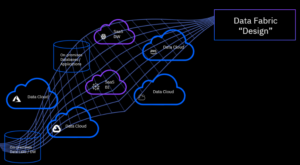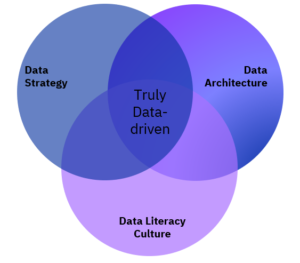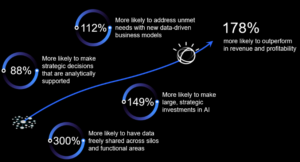In today’s age of the unexpected, increasing revenues and reducing costs, enhancing
customer retention and loyalty, improving efficiency across the value chain, and
gaining competitive advantage are challenges organizations deal with every day.
Organizations can achieve these goals by leveraging data from within and outside
and putting it right in the hands of every employee along with insights for taking
the right decisions at the right time.
In other words, organizations need to be truly data-driven.
But what does it mean to be truly data-driven? Why is it important? Is your organization truly data-driven? How do you become one?
What does being data driven really mean?
Data-driven organizations use data in a manner that informs decision making, and
strategically addresses unmet needs with new data-driven business models. There
are three basic tenets of a data driven organization:
- Data Strategy: Treats data as a strategic resource and a true differentiator, which
means the organization has a data strategy that connects to its business strategy. - Data Architecture: Connects the right people, to the right data, at the right time
to promote agility and predict outcomes, which means the organization has the
right data architecture to help deliver on its data strategy. Modernized data
architectures ensure employees can find and explore data themselves to glean
insights that shape data-driven decision- making. - Data Literacy Culture: Having the data strategy, tools and processes is one
thin, but it’s important that the organization has a culture of data literacy that
makes it possible for everyone in the organization to make better, data-driven
decisions that lead to better results.
As per IBM Institute of Business Value Study of 13,000 c-suite leaders, truly data
driven organizations are able to derive real benefits, as captured in this graphic.
The bottom line: You must outperform your competitors on data or risk being outperformed by them
Challenges in becoming a data driven organization
The key to becoming a data-driven organization is to overcome the challenges that
come in the way:
- Data volume:
The enterprise data volume continues to rise, with some industry
estimates suggesting a growth of 42% in the 2020 to 2022 period. - Data access and usability:
Even as data volumes continue to grow, and data remains pervasive, its usability remains a challenge, with 60–73% of all data being unused, per IDC estimates.
A similar study by Seagate points out that 68% of the data is not analysed. - Data siloes and complexity:
Organizations today are struggling with increasingly complex data architectures
as data becomes more diverse, distributed, and dynamic across hybrid cloud environments. It is important that organizations understand what data they have,
where that data resides and how it can be used. - Data quality:
A Forrester report found that for 58% of organizations data quality is
the number one data challenge. Not surprising that only 20% of business
executives completely trust the data they get. - Data compliance:
Today, more than 60 jurisdictions around the world have enacted
or proposed privacy and data protection laws, and by 2023 more than 80% of
companies worldwide will face at least one privacy-focused data protection
regulation.
But, how do you overcome these challenges?
To overcome these challenges, organizations need to create a way to access data
wherever it resides while managing the demands of compliance, security and
governance risks, at the same time as identifying real-time insights that will drive
the business forward.
To put it in fewer words, you need a new architecture to be a data-driven organization.
Data fabric is that architectural approach that simplifies data access in an organization. It is an an abstraction layer to share and use data across a hybrid cloud landscape. It connects the consumers of the data to the sources of the data, unites disparate data systems with end- to-end data management and governance, simplifying self-service data access and collaboration.

A data fabric allows a data driven organization to:
- Integrate data across any cloud:
The goal of multicloud data integration is to democratize data access across the organization, enable continuous availability for mission-critical data, and empower new data consumers, while keeping true to secure, governed, and performant principles. See how data fabric approach to multicloud data integration enabled with solutions like IBM Data Stage can transform structured and unstructured data at scale from different sources into a trusted, unified view. - Automate data governance at scale:
Data fabric strengthens compliance with automated governance and privacy controls, while maintaining regulatory compliance no matter where the data resides.
Read how strong governance makes the right, quality data easier to find for those
who should have access to it, with building blocks like cataloguing, data virtualization, metadata generation etc. - Build trustworthy AI models:
AI today is essential to success of an organization. As the outcome of AI models
and insights become more business critical, there is a dependence on them
operating reliably and transparently, without bias. Data fabric provides a strong foundation for trustworthy AI, helping to ensure that quality data can be accessed
by the right people, at the right time, no matter where it resides. - Create a 360 view of customers:
Creating a 360° view requires breaking down silos to develop an integrated view
of all your data that’s in near-real-time and ready for analytics. Instead of a
fragmented group of products that have been stitched together, a data fabric
offers a single, holistic solution that is built to work seamlessly.
Also read: https://smeventure.com/grow-fearless-with-zero-trust/
To summarize, you are a data company. Whatever be your industry, whatever be your target customers, whatever be your business goals. You need to put data to work across complex digital systems to navigate the unexpected, enhance customer experiences, and uncover new opportunities. To do so, you must provide organization-wide access to previously siloed data, configure governance policies, and address data quality concerns.
A data fabric is an architectural approach that simplifies access to quality data in an organization to facilitate self-service data consumption in a secure and governed manner to help you become a data-driven organization.
Do watch:https://www.youtube.com/shorts/DsawkXKoGGo
Authored by
Pradeep Iyer, Segment Leader, Data & AI, IBM India & South Asia



